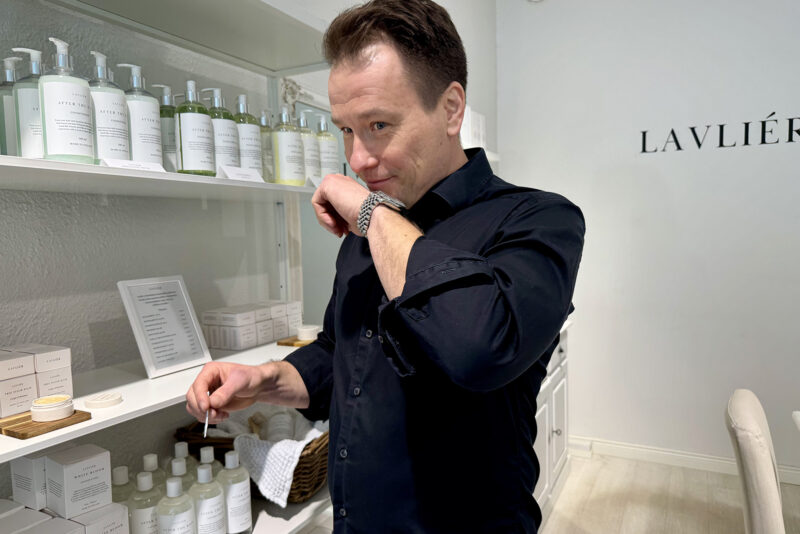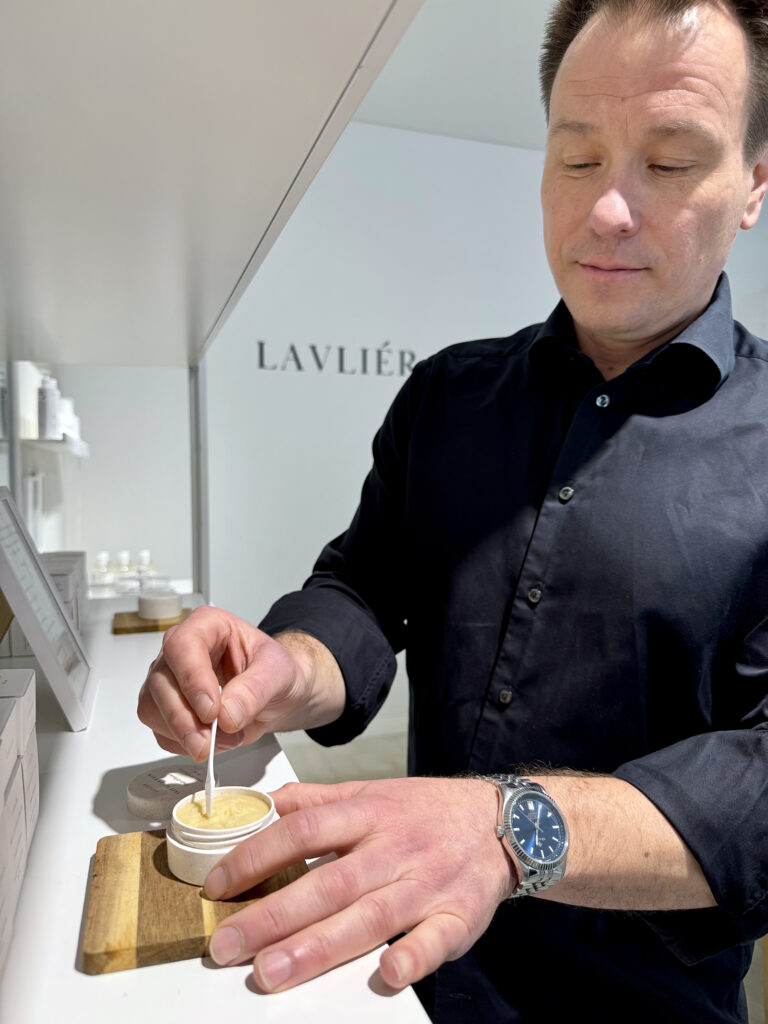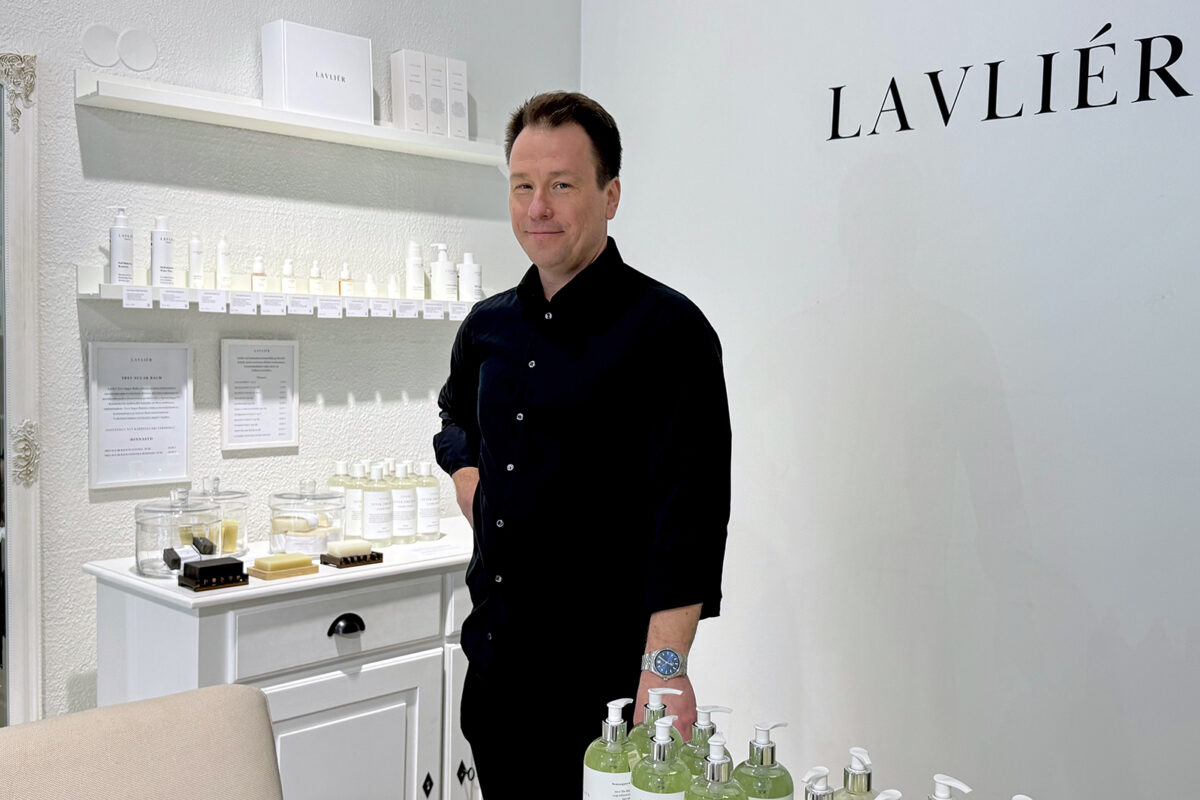Wood innovator Petro Lahtinen: ’Our technology has a good potential to revolutionize the entire cosmetics sector’

Finnish company aims at replacing the chemicals used in the cosmetics industry by a wood-based raw material and a new technology.
- Petro Lahtinen, founder of the Woodio company, switched over to the cosmetics industry, convinced that he has developed a manufacturing technology to revolutionize the entire sector.
- Lahtinen’s new company Lavliér is developing a technology aiming at replacing the numerous additives used in cosmetics by a ’base’ derived from wood.
- The company aims at launching the first products made with the new technology next year. After this, Lahtinen wants to convince the big actors in the cosmetics branch to use the technology.
Lavliér’s brick-and-mortar shop in Helsinki is choc full of elegant pots and subtle scents. It is all very harmonious and beautiful, though not that exceptional.
At first glance, you would not guess that this is a company that plans to revolutionize the entire international cosmetics industry. But this is indeed the case, we are assured by Petro Lahtinen, Doctor of Chemistry, known for his wood-related innovations.
’I wouldn’t try to enter the super-competitive cosmetics branch if I didn’t know that we’ve got something truly path-breaking and special. Something the world has never seen,’ Lahtinen assures.
’We’ve got a technology that has good chances of thoroughly revolutionizing the way cosmetics are made in the future.’
In fact, the pioneering technology is not yet to be found in Lavliér’s elegant shop, but in the back room, where Petro Lahtinen fiddles with a small pump bottle containing a transparent, gel-like liquid.
’I’ve been working with this kind of thing for so long that I’ve learned to be a bit careful. I wouldn’t begin to make noises too early, and so I’ve checked this with both customer and the industry. We’ve really got something unique,’ Lahtinen says.
Among other things, Lahtinen is known for developing the wood-based Woodcast plaster cast material. He is the founder of Woodio, a company known for bathroom fittings made of a wood composite. He has also been at the background in Sulapac, a company using a wood-based material developed to replace fossil plastics in cosmetics packagings.
Wood-based material and novel production technology to replace cosmetics additives
Little by little, we are beginning to understand. This is not really about the products found in the Lavliér shop right now – or even in the future. The point is that Petro Lahtinen believes he has developed a production method that will completely change the composition of cosmetics industry products.
’As things stand now, most of the raw materials of cosmetics products are what are called additives, used to improve the appeal and shelf life of the products. In addition to the active substance – such as vitamin C – the products contain dozens of chemicals, causing an absolutely unnecessary exposure for both people and the environment,’ Lahtinen explains.

The purpose of the ’miracle ingredient’ in Petro Lahtinen’s pump bottle is to replace all those unnecessary additives. It is designed to form a base to whic the active cosmetic substances are added using a completely novel method.
This is all that will be needed. And, since the inventor is Petro Lahtinen, who has worked all his life with wood-based innovations, it is natural that the substance used as base is derived from the forest.
’Thanks to our technology, we are able to produce this fully chemical-free base, and only the active substances need to be added to it. The list of ingredients in our prototypes is the shortest in the world. And I stress that this is really about the technology used to make the products,’ Lahtinen emphasizes.
’No chemicals’ attracts consumers and lowers production costs
Petro Lahtinen believes that once the new technology is adopted by big global names, the use of chemicals in the cosmetics industry will go down by millions of tons.
’We’ve already had talks with three major actors, and all of them have promised to adopt our technology as soon as we have finalized it.’
So this miraculous new technology is not yet complete. So far, none of the products sold in Lavliér’s beautiful shop is produced using it – not even the balm containing spruce sugar and sold under the brand name Forest CosmeticsTM. It does, however, contain fewer chemicals harmful to the environment, thanks to the use of forest-based raw materials.
But what, then, is the purpose of these white pots of natural cosmetics with their wonderful scents, if the main aim is to sell a new type of production technology to global cosmetics giants?
’All this has helped us to learn an enormous amount about the cosmetics branch and of the actual production processes, and we have created an interface with the consumers,’ says Petro Lahtinen.
As a result, Petro Lahtinen and his business partner Jenna Tikkanen are convinced that chemicals-free products do interest the consumers – in addition to the fact that they will be a great deal less costly to make.
’Wood-based innovations are a must for humankind’
While learning about the cosmetics branch and talking to major actors, Lahtinen and Tikkanen have noticed that ’chemicals-free’ is the key attraction.
’We’ve noticed that talk about Forest Cosmetics does not resonate sufficiently with the cosmetics branch. That’s why we’ll use another name to launch the new technology,’ Lahtinen says.
None of this changes the fact that once again, wood and forest are the foundation for Petro Lahtinen’s work.
’Wood-based innovations are a must for humankind. There are no other similar, renewable materials on Earth that would exist in similar quantities, cultivated or not.’
’Forests can grow without human intervention and don’t need irrigation. The technologies for utilizing forests are developing at a great rate. I believe we’ll start making all textile fibres, as well as fuels, from wood. Wood-based plastics are already quite easy to make. I believe that this is a good – and a necessary – future,’ Lahtinen says.
What still needs to be asked is, when will this revolutionary technology take the leap from the shop back room to the shelves of cosmetics boutiques.
’We’ll definitely launch the first products through Lavliér. Fates permitting, this’ll be some time next year. And then, we hope that the technology will be adopted by the big actors in the cosmetics branch.’
’Researchers like to research, and they don’t know how to productise and commercialize their innovations’
Calling Petro Lahtinen the Gyro Gearloose of the wood innovations sector would not be unreasonable. Among other things, he has developed the wood-based Woodcast plaster cast material and the Woodio bathroom fittings made of wood composite, as well as co-founding Sulapac, a company hat makes packaging material of wood.
Asked to reflect on his personal history, he immediately locates a critical point – which, according to him, is common in the scientific community.
’From the very beginning, the productisation of the innovations could have been better. It’s a universal problem that researchers like to research. And that’s absolutely necessary, but then they don’t know how, or never think of to productise and commercialize their innovations – in other words, how to bring them to a shape that someone is willing to pay for,’ Petro Lahtinen says.
’You’ll see this in the business ideas of many start-up companies: they talk about developing their own thing further, instead of selling it or providing the solution to a problem.’

According to Lahtinen, he has adopted a completely different mentality with Lavliér: his point is to solve the problems that customers have.
’People in the scientific community are often proud and enthusiastic about their innovations, but they don’t spend enough time thinking about what use they will be and to whom. With Lavliér, we started out with me visiting cosmetics companies to find out what they need and how our innovation could help them.’
How, then, could this problem with productisation be helped? There is probably no silver bullet, but Petro Lahtinen would like to see more mentoring, peer support and ’productisation training’. In this way, not everyone would have to learn things the hardest way.
’The New Wood programme is a great example of a step in the right direction,’ Lahtinen says, in praise of the project by 20 Finnish forest-sector organizations, designed to provide information on wood-based bioeconomy and innovations within it.
Petro Lahtinen also hopes that more funding could be available for the very first stages of projects.
’That’s the most challenging stage: how do you pay yourself a salary for the first couple of years when you don’t have an awful lot to show. By the time your activity needs tens of millions to build a factory, you should have reached the level of credibility that allows you to find investors on your own.’